The leaves are grown,
Green again.
And come the Autumn,
They will brown
And fly towards
The beckoning ground
While talking Summer
And learning Winter.
Steve Coxon, April 2010
Filed under: Musings | Leave a comment »
The leaves are grown,
Green again.
And come the Autumn,
They will brown
And fly towards
The beckoning ground
While talking Summer
And learning Winter.
Steve Coxon, April 2010
Filed under: Musings | Leave a comment »
A couple of months ago, I registered our home phone number with the Telephone Preference Service. Basically, this means that companies who use cold-call telesales and telemarketing techniques are not allowed to call you. It’s simple and it works.
So, when telecoms company Talk Talk called me and wanted to speak to me about my telephone account, I pointed out that – as they should have known – my number is off-limits to them.
Their response: they were calling because there had been “a visit” to the (Talk Talk) website.
They weren’t calling to let me know about the “visit” because they were so excited about it. No, according to Talk Talk, I had gone to their website and filled in some type of request for them to phone me.
Theirs must be a really special site. Because, to the very best of my recollection and knowledge, I have never ever visited the Talk Talk website. Never. Ever.
But, despite this, they tried to argue that I must have contacted them. Even though I hadn’t.
In fact, they argued with me that I was wrong and they were right. There had definitely been “a visit” to the website.
Of course, I wouldn’t possibly suggest that perhaps someone paid “a visit” to the Talk Talk website on my behalf and without my permission. I know that it wasn’t my fiancee. Melinda, like me, has also never, ever visited the Talk Talk website.
Whoever it was who came up with the dumb idea of circumventing the Telephone Preference Service by forcibly introducing me to Talk Talk via “a visit” to their website – and, naturally, I am assuming here that it couldn’t possibly be Talk Talk themselves – is going to be disappointed with the result.
If Talk Talk ever make another unsolicited sales call to me again, I’ll start by reporting Talk Talk to the Telephone Preference Service. In the meantime, I’ll tell everyone I know what I think about the company. Starting with you.
And what I think is this: any company that is so incredibly desperate to make a sale by starting their sales argument with an actual argument is probably best avoided. Talk Talk’s sales tactics stink and in my view, by association, so does the whole company.
Filed under: Advertising | Tagged: Talk Talk, telemarketing, telesales, unwanted sales calls | 1 Comment »
I know next to bugger all about some American bloke called Bob Hoffman. Which is fine as he almost certainly knows absolutely nothing about me.
The little I do know is that he writes a blog called The Ad Contrarian.
Now, if you want to strip away all the rubbish that gets spewed in the ad business and find out what it’s really all about, you could do a lot worse than starting there.
Brilliant.
Filed under: Advertising, copywriting | Tagged: Advertising, Bob Hoffman, copywriting | 1 Comment »
When I went to London recently for a Friday business meeting, Melinda and I decided to extend the stay and make a weekend of it.
Our plans included a visit to the Cabinet War Rooms and walking a labyrinth.
The Cabinet War Rooms is an underground complex of reinforced basements and offices that acted as the nerve centre of the British Government during WW2. This remarkably small space is a couple of flights of stairs below what in 1939 was the Office of Works and the Board of Trade – just off Whitehall. It is frugal, cheaply decorated, and purely functional. No expense was wasted on decoration or aesthetics. Everything and everyone that came into this space shared a single, specific purpose.
When Churchill first saw it, he recognised that purpose, saying: “This is the room from which I will lead the war.” And he did. Around him, were assembled typists, maps (bought off the shelf from general stationers, not created by military cartographers), telephones, offices and bedrooms for his chief advisers. A head office, in other words, from where the activities and fates of millions upon millions of people could be choreographed.
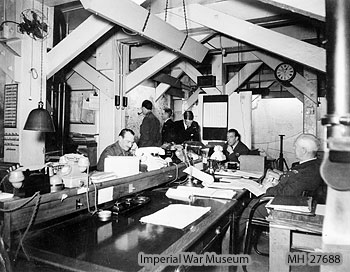
Map Room Officers at work in the Cabinet War Rooms. The Royal Air Force officer sitting at the end of the table has been identified as Wing Commander John Heagerty. Copyright: Imperial War Museum
It is an extraordinary and raw example of the power of organisation. I’d recommend a visit to anyone who wants to see at first hand the nuts and bolts of how any group of people can be led in a dance that has no set moves and no predictable end.
That afternoon, Melinda and I took a bus up to Hamspstead Heath to walk a labyrinth. Now, a labyrinth should not be confused with a maze. While a maze is designed to test your abilities to choose the correct path from among many options, a labyrinth has just one route in and out from its centre.
The labyrinth we were to walk is an exact copy of the famous one at Chartres Cathedral. This particular design was created during the time of the crusades, when it was difficult for Christian pilgrims to go to Jerusalem. Instead, walking the labyrinth was regarded as being akin to making the pilgrimage. The design, however, predates Christianity and is thought to have been used as an aid to meditation and prayer for thousands of years.
Our Hampstead labyrinth – although of the same dimensions and design as Chartres – was slightly less ancient and certainly less durable. It was printed onto canvas and spread across the floor of the Rosslyn Hill Unitarian Chapel.
We were under the guidance of Danielle Wilson, who explains her personal ‘interfaith’ credo on her website: “I see interfaith as rising above all faiths and subscribing to none, all the while honouring the beauty and wisdom deriving from other faiths.”
Melinda had walked a labyrinth before. For me, it was a first experience and I wasn’t sure what to expect. All I knew was that I wanted to keep my mind and my soul as open as possible to the potential of this tool that had been used by spritual people for millennia.
You enter the labyrinth at a time you choose. You walk at a pace that is comfortable for you. And, while you walk, you let your mind focus on anything or nothing. The very act of following a path that winds and wanders, meandering towards the central core liberates your mind from having to think about the mundanity of choosing where to walk.
So how was it for me? I wasn’t prepared for the sheer physical power of the experience. I could feel my heart pounding and I became profoundly aware of each breath as I walked, my eyes focused on the path.
I was also very aware of other people who were following the same path, but in their own way and with their own thoughts. The path became our choreographer as it led us on a spiritual dance of our own making. Some people stayed in the centre to sit and meditate, but I didn’t. There were too many people there and too little space to breathe freely. So I carried on along the path. And all the time I was aware not only that I was part of the informal dance that was going on around me, but also that I was separate and individual.
On Monday morning it was time to return home. Before we left, Melinda wanted to buy a particular weight and texture of paper that she had spotted in an art supplies shop in SoHo. While she did that, I went to see the changing of the guard at Buckingham Palace. This is one of those cheesy tourist attractions that stinks of pageantry, history and tradition. It’s sneered at by many, adored by many more.
I’d never seen it, so I took my camera and joined the throngs around the railings of the palace. The changing of the guard is, quite simply, the point at which one set of sentries is replaced by another. In some ways, it is purely an administrative procedure – a bit of military housekeeping. But, in other ways, the choreography of the event is is much more powerful.
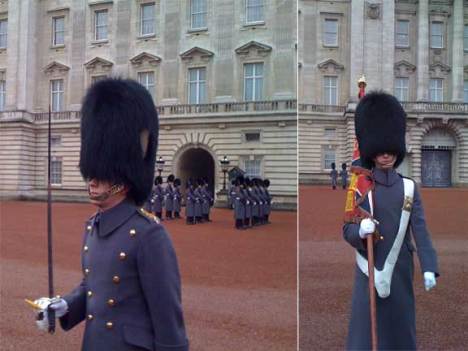
Changing the Guard
These guards are dressed in uniforms that go back a couple of centuries. Their high bearkskin hats, their greatcoats, their drill are all designed to make each soldier look much like the other. The message is simple: the faces and the bodies of the soldiers may change, but the guard is constant.
Arms are shouldered and presented. Ranks are formed and straightened. Officers and colour bearers march from side to side of the palace in a measured pace. The bands play.
In the meantime, thousands of cameras take pictures that will be smiled at across the world. Yet, these young men and women are not here just for show. These are faces you will see in desert camouflage, on your TV, in the dust of Afghanistan. These are real soldiers who, away from the tourist cameras, take part in much more deadly manoeuvres.
All of which brought me full circle back to the Cabinet War Rooms and the thought that all our lives are choregraphed in some way. But, ultimately, it is we who choose whether or not – and how – we take part in the dance.
Filed under: Travel | Tagged: Buckingham Palace, Cabinet War Rooms, Chartres, choreography, Churchill, Danielle Wilson, Labyrinth, London | Leave a comment »
Cogent is an advertising agency that has been around since the 1930s. So they’ve seen recessions come and go. It was interesting, then, to see their current creative director Richard Payne’s take on what it takes to apply creativity successfully these days.
He talks a lot of sense and echoes my own views. Great ideas should be able to work across media and be independent of the size of the budget. Just as importantly, creatives should always remember what their role is: to use their creative skills to sell the client’s products and services. Awards and gongs are nice and glittery, but they’re not the aim of the job. If you want your creative genius to be recognised for itself, write a book, make a film, make a painting, carve a statue or create a play.
It will be interesting, in this context, to see what Manchester-based BJL do with their recently announced Art in Advertising exhibition, which is due to open at The Lowry gallery in Salford Quays on 25th January 2010.
Art in Advertising photo from The Lowry website
Filed under: Advertising, Birmingham, copywriting | Tagged: Advertising, Cogent, creative director, Creativity | 1 Comment »
This set of pics uploaded by Exeter Northcott on flickr gives a flavour of the event.
Filed under: About Me, Art, Events, Fiction, Scripts | Tagged: Exeter Northcott, Sidwell Street, Trading Local | Leave a comment »
Here’s the piece I wrote recently for Trading Local – a series of monologues delivered by professional actors in shops in Exeter’s Sidwell Street. Actor Eli Thorne did a great job of interpreting my script in a way which was a little subtler than the voice I had in my head when I was writing it.
The Trading Local exercise was organised jointly by Exeter Northcott Theatre and Show of Strength of Bristol.
Vodpod videos no longer available.Each actor performed a number of monologues – reading from a script – in 15 different shops, with each monologue receiving up to three performances. A total of 47 performances on the day.
One of the questions I kept being asked was what I thought of the way the piece was presented; didn’t it worry me to simply hand it over to someone else with no power over how it would be interpreted?
The simple answer is that it didn’t bother me at all. In fact, part of the joy of creating something like this is the handing over. You give the words to someone else and they add their own perception to it. I saw my character as a little edgier and harder than the way Eli interpreted him. But, in truth, Eli’s take had much more depth and was more realistic than the voice I heard as I wrote the words. I love that process of discovery, of finding things that you never knew you had built in to something you have created.
Melinda and I managed to catch virtually all of the other monologues on the day, with three standing out for me. After Hours by Margaret Murphy was told from the point of view of a chair in a furniture shop and let us into the discussions that the various bits of furniture have with each other after the shop is closed. Quick as a Flash by Ben Cannon was a great insight into the life of a wedding photographer who lived vicariously,taking photos of the special moments in other peoples lives without having any of her own. And the superb The Philosopher Barber by Belinda Dixon followed a theme similar to my own. I don’t know how the other writers reacted to the way in which their pieces were interpreted, but I hope they enjoyed it.
Trading Local is a great idea which I know Show of Strength hope to expand into other communities in the future. If they do – and you get a chance to take part or to see it – it comes highly recommended.
A slightly shorter version (cut-down titles) is also available on YouTube.
Filed under: About Me, Art, Fiction, Scripts | Tagged: Afghanistan, British Legion, Eli Thorne, Exeter, Exeter Northcott, Helmand, Poppy Day, Remembrance Day, Show of Strength, Trading Local | Leave a comment »
A few weeks ago I noticed a flyer from Show of Strength theatre company, working in conjuction with Exeter Northcott Theatre. They were looking for 5-minute monologues from local writers to be performed in shops in Exeter’s Sidwell Street.
The idea – labelled Trading Local – intrigued me. So I wrote something, sent it off and was absolutely delighted that my piece has been chosen to be performed.
Not All There is one of dozen or so monologues that will be performed on the day – this Saturday 14th November.
You can find the full programme here. It will be interesting to see how an actor interprets my words and to see the audience reaction. I’ll get back to you with my own reaction after Saturday.
Filed under: About Me, Events, Fiction, Scripts | Tagged: Exeter Northcott, Show of Strength, theatre, Trading Local | Leave a comment »
Private Robert Arthur Coxon of the 8th Battalion, Seaforth Highlanders was my great-uncle. The Commonwealth War Graves Commission records the date of his death as Sunday, 25th September 1915 – the first day of the Battle of Loos. He was 24 years old.
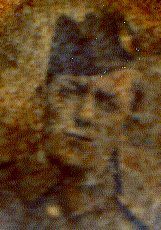
Robert Arthur Coxon. Captured at the Battle of Loos, 25th September 1915.
We know, because someone close to our family saw it happen, that Robert was – in fact – captured by German troops on that day. But, his body was never found and he was never seen alive again by anyone who knew him.
This story has fascinated me since I was boy. He was caught up in a German counter-attack and was isolated. Despite his mates “knocking off five or six” of the enemy who were closing in on Robert, he was eventually overwhelmed. As he was led away to the German lines, he turned to his own lines, smiled, waved and….well, we don’t know.
So where – exactly – was he captured? Who were the troops who took him away? If he was murdered by those troops, what were the circumstances? Or could he have been caught up in a British bombardment – a victim of friendly fire while he was in unfriendly hands?
Robert was part of the first wave of British soldiers in the 44th Brigrade of the 15th (Scottish) Division to attack the German trenches at Loos, in Flanders. The attack was preceded by a 40 minute release of smoke and chlorine gas, the first time the British had used the weapon. 5,000 cylinders of the stuff – each 6 feet long and weighing 150 pounds were used.

Robert's rosary. Given to him by his Catholic fiancee. She never married.
The reason for the use of the gas was twofold. Firstly, there wasn’t enough artillery available of the right type to mount a sufficiently heavy bombardment. Heavy guns were needed, big howitzers with a high trajectory that would land a high explosive shell directly into a trench or fortification. Instead, we had smaller field guns – 18-pounders – that fired shrapnel. These were useful for wirecutting, but only where the wire could be seen easily by spotters and adjusted for effect.
Another problem was the availability of shells. British weekly production levels (22,000) were very low compared to French and German output (100,000+). This meant that any bombardment would be limited by the stocks of ammunition available.
Neither Haig (in charge of the First Army, tasked with the attack) nor Sir John French (overall commander of the British Expeditionary Force – BEF) actually wanted to launch an attack.
In fact, the considered view of the British military was that Loos was “unfavourable ground” for an attack. It was a mining district, very flat, but littered with slag heaps and pithead towers. In other words, hardly any cover but lots of vantage points for defenders.
The French army under Joffre, however, was planning a major offensive and wanted the British to provide a large-scale diversion. Lord Kitchener, head of all British forces, changed his position from opposition to British involvement to supporting it – but not out of any love of the French attack plan. Kitchener’s main concern was that the Russians – suffering badly on the Eastern Front – would withdraw from the war if they could not see action being taken by their British and French allies in the West.
So, reluctantly, the British made their plans. Gas became a decisive factor in the battle plan after Haig saw a sucessful demonstration of its use. In his eyes, the weapon that the Germans had used to good effect some months earlier, would compensate for the lack of artillery support.
At 5.50am on the morning of the attack, the attacking formations were in their starting positions, ready for the assault.
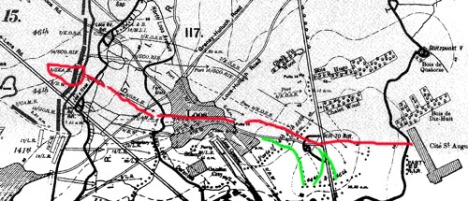
The British attack. The red line shows the starting position and intended attack route of the 8th Seaforths. The green lines show where some - including Robert - actually attacked.
The gas was unleashed. In some places it was blown gently towards and into the German trenches. In other places, it stayed in no-man’s land. And in others – as in the case of the 8th Seaforths – the gas drifted back into the British trenches. The gas attack, mixed with smoke shells, lasted for 40 minutes – 10 minutes longer than the effective working life of a German gas mask.
At 6.30am, wearing respirators, the British left their trenches and headed for the German first line. Robert’s sector – the 15th (Scottish) Division – were to experience the most successful advance of the day.
The first German line was taken within 15 minutes at the cost of Lieutenant-Colonel Thomson, all four of the Seaforth’s company commanders and about 100 other casualties.
Rushing forward, the Seaforths and the 9th Black Watch pursued the fleeing Germans into the village of Loos before the garrison there had time to mount a strong defence. The village was the scene of vicious and often unrestrained fighting. many German prisoners were ruthlessly killed and the bayonet was freely used. You get some flavour of it all from this eyewitness account.
Leaving Loos, the troops – including Robert – moved onto their next objective, Hill 70. By this time, many of the regiments were intermingled. As many of their officers were casualties by now, there was also a lack of leadership on the ground.
Hill 70 fell quickly as the German defenders saw that the oncoming British troops had made short work of both the German front line and the Loos garrison and fled towards their second line defences at Cite St. Laurent.
Robert was with a group of around 500 or so troops who chased the Germans down the hill towards Cite St Laurent. In fact, they should have continued their advance towards their original objective of Cite St Auguste.
The wire in front of Cite St Laurent was up to 15 feet thick in places. And the line was protected by a fortified strongpoint – the Dynamatiere. By the time Robert and the other troops reached the German line, they were trapped by fire from the strongpoint and from the German lines ahead. They dug scrapes in the ground for shelter and waited for reinforcements.
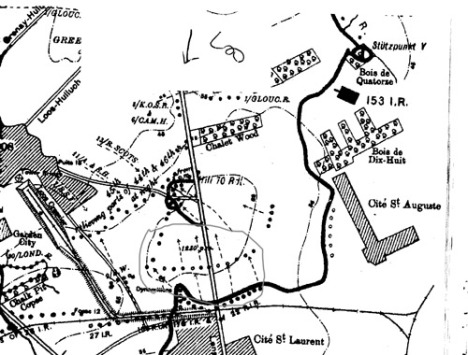
Around 12.30pm to 1pm. The German lines at Cite St. Laurent. The last place that friendly eyes saw Robert alive.
But, up on Hill 70, the few officers remaining saw that something had gone wrong. The artillery was continuing to pound the original objective of Cite St. Auguste and offering no support to the beleaguered troops in front of Cite St Laurent. The promised reserves who were supposed to be ready to pour in behind the 15th (Scottish) Division and force a breakthrough, had not arrived in time to take a useful part in this first day of the battle.
By around 12.30pm, Robert and the other troops with him were low on ammunition and were looking for a way to get back to Hill 70. Some made a break for it when the Germans launched a counter attack. Seeing the Scots run encourage more Germans to join in the assault.
It was around this time that Robert was seen to be captured.
Of the 500 British troops trapped in front of Cite St. Laurent, the Germans reported that only 50 were taken prisoner unwounded.
The troops who captured Robert were from 117th Infantry Division, largely recruited from Silesia. The troops directly opposite Robert were largely from the Division’s Reserve-Infanterie-Regiment Nr. 22, supplemented by troops who had fled both from Hill 70 and Loos. These are the troops who, probably, captured Robert during their counter-attack on Hill 70. And some of these troops, at least, would have seen how some of their comrades had been slaughtered in Loos.
On 23rd April, 1917, the Australian newspaper The Hobart Mercury carried this report:
“The Amsterdam correspondent of the “Daily Chronicle” says he has obtained from a reliable source the statement of an educated German deserter as to the shooting of British prisoners. … 200 British soldiers who were taken prisoner at Loos were sent to Frankfort, but only 80 arrived, the remainder being shot.”
I don’t know whether or not this report – written in wartime – has any credence or any relation to the fate of my great-uncle Robert. All I know is that – all these decades later – by researching his story I have felt myself drawn closer to a man whose rosary beads I touched today and whose photograph I scanned for this post.
Rest in Peace, Robert.
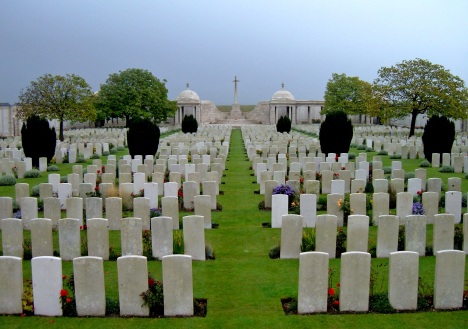
The cemetery at Dud Corner, Loos. Robert's body was never found. His name is listed among the missing.
In looking into Robert’s story I used these research sources:
Loos, 1915 by Nick Lloyd, published by The History Press.
Loos, Hill 70 by Andrew Rawson, published by Pen & Sword Books.
History of the First World War by Liddell Hart, published by Pan.
The Fifteenth (Scottish) Division 1914-1919, J. Stewart & John Buchan, Naval & Military Press
Histories of the 251 German Divisions of the German Army, USAEF, London Stamp Exchange Ltd.
War Diary of the 8th Battalion Seaforth Highlanders, National Archives.
Most Unfavourable Ground, by Niall Cherry, published byHelion & Company Ltd.
The Battle of Loos, by Philip Warner, published by Pen & Sword Books.
British Official History, Military Operations, France & Belgium 1915, published by Battery Press.
Filed under: History, Stoke-on-Trent | Tagged: 15th Division, Battle of Loos, Hill 70, Longton, Robert Arthur Coxon, Seaforth Highlanders, Seaforths, September 25th 1915, WW1 | Leave a comment »
Recently, I was working on the website for a major British retailer. They – or rather their agency – wanted me to write captions for the products that feature on their website.
It’s writing for the web. So, they wanted to do more than simply sell the product. They wanted SEO – Search Engine Optimisation. Keywords needed to be built into each caption to reflect the search terms that people use when they search for that particular type of product.
Now, I’ve got a vague idea of how the technology works: I’ve been on Axandra’s search engine tips e-mailing list since about 1998. I’ve also recently signed up for Google Analytics on my own website. But, the technology is not my concern.
My job is to write the words.
Writing for search engine optimisation (or optimization if you’re reading this in the USA or Canada), really isn’t very difficult. You simply have to weave in the words you’re given.
The job of the copywriter is to make those words make sense. This is also easy, provided you follow a few simple rules.
Rule 1: Write it so that it makes sense to your target reader.
Rule 2: See Rule One.
Rule 3: If you can’t write it yourself in a way that’s engaging and meaningful, pay someone to do it for you. (Someone like me, naturally.)
Working with key words or phrases for a website is no different from working with a set of corporate values. The words have to be merged seamlessly in to the text without getting in the way of a meaningful statement.
For example, say you’re selling low-priced tissues that have a special balm to make them softer on the skin. Now, say that your web stats show that the top key words and phrases people use to reach your site are: “red nose”, “runny nose”, “sore” and “cheap tissues”.
You only have space for 40 words – and seven of them have been dictated to you. Here’s how I’d handle it:
“Some cheap tissues leave you with a sore, red nose. Ours have a soothing balm that’s soft and kind to your skin when you’ve got a runny nose. Great value,too, at just 99p a pack!”
It’s a meaningful statement. (Well, as meaningful as you’re going to get when you’re writing about tissues.) And it includes all the key words and phrases in a seamless way. Plus, notice how I got over the product feature – “soothing balm” – and turned the price proposition around from “cheap” to a more positive-sounding “value”.
And it only took me 27 years in the business to do that so easily.
So, what were the results from my most recent SEO exercise? The site’s updated copy is about to go live. If I hear any results, I’ll get back to you.
Filed under: About Me, Advertising | Tagged: copywriting, Search Engine Optimisation, Search Engine Optimization, selling on the web, SEO, writing for the web | 3 Comments »